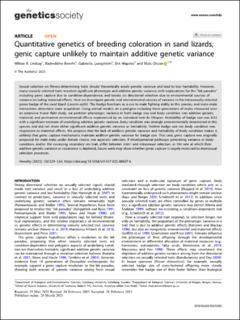| dc.contributor.author | Lindsay, Willow R. | |
| dc.contributor.author | Bererhi, Badreddine | |
| dc.contributor.author | Ljungström, Anna Jeja Gabriella | |
| dc.contributor.author | Wapstra, Erik | |
| dc.contributor.author | Olsson, Mats | |
| dc.date.accessioned | 2023-08-14T11:09:01Z | |
| dc.date.available | 2023-08-14T11:09:01Z | |
| dc.date.created | 2023-03-30T17:50:49Z | |
| dc.date.issued | 2023 | |
| dc.identifier.issn | 0018-067X | |
| dc.identifier.uri | https://hdl.handle.net/11250/3083814 | |
| dc.description.abstract | Sexual selection on fitness-determining traits should theoretically erode genetic variance and lead to low heritability. However, many sexually selected traits maintain significant phenotypic and additive genetic variance, with explanations for this “lek paradox” including genic capture due to condition-dependence, and breaks on directional selection due to environmental sources of variance including maternal effects. Here we investigate genetic and environmental sources of variance in the intrasexually selected green badge of the sand lizard (Lacerta agilis). The badge functions as a cue to male fighting ability in this species, and male–male interactions determine mate acquisition. Using animal models on a pedigree including three generations of males measured over an extensive 9-year field study, we partition phenotypic variance in both badge size and body condition into additive genetic, maternal, and permanent environmental effects experienced by an individual over its lifespan. Heritability of badge size was 0.33 with a significant estimate of underlying additive genetic variance. Body condition was strongly environmentally determined in this species and did not show either significant additive genetic variance or heritability. Neither badge size nor body condition was responsive to maternal effects. We propose that the lack of additive genetic variance and heritability of body condition makes it unlikely that genic capture mechanisms maintain additive genetic variance for badge size. That said, genic capture was originally proposed for male traits under female choice, not agonistic selection. If developmental pathways generating variance in body condition, and/or the covarying secondary sex trait, differ between inter- and intrasexual selection, or the rate at which their additive genetic variance or covariance is depleted, future work may show whether genic capture is largely restricted to intersexual selection processes. | en_US |
| dc.language.iso | eng | en_US |
| dc.publisher | Nature | en_US |
| dc.rights | Navngivelse 4.0 Internasjonal | * |
| dc.rights.uri | http://creativecommons.org/licenses/by/4.0/deed.no | * |
| dc.title | Quantitative genetics of breeding coloration in sand lizards; genic capture unlikely to maintain additive genetic variance | en_US |
| dc.type | Journal article | en_US |
| dc.type | Peer reviewed | en_US |
| dc.description.version | publishedVersion | en_US |
| dc.rights.holder | Copyright 2023 The Author(s) | en_US |
| cristin.ispublished | true | |
| cristin.fulltext | original | |
| cristin.qualitycode | 1 | |
| dc.identifier.doi | 10.1038/s41437-023-00607-8 | |
| dc.identifier.cristin | 2138673 | |
| dc.source.journal | Heredity | en_US |
| dc.source.pagenumber | 329-334 | en_US |
| dc.identifier.citation | Heredity. 2023, 130, 329-334. | en_US |
| dc.source.volume | 130 | en_US |

